what is the 3rd planet in the solar system
A satellite is a large and ring-shaped physics object that orbits roughly its sun. Our solar organization has 8 planets, and all eight planets are mentioned at a lower place ready of increasing distance from the sun:
- Mercury – 1st planet from the sun,
- Venus
- Earth
- Red Planet
- Jupiter
- Saturn
- Uranus
- Neptune – 8th planet from the insolate.
These were all 8 planets in order from the sun of our solar system of rules. Separate from the ogdoad planets, our solar system has 5 dwarf planets, hundreds of moons that orbit planets, millions of asteroids, comets, and, another little star system objects are addressable.
Here in this clause, we have mentioned our eight solar system planets list with some interesting facts and selective information.
Types of Solar Scheme Planets
Primarily, there are deuce types of planets in our solar system:-
- Terrestrial or inner planets – Hg, Venus, Earth, and Mars.
- Giant Beaver State outer planets – Jupiter, Saturn, Uranus, and Neptune
Reported to scientists, our Universe has billions of planets but our solar system merely has 8. There are other several types of planets that exist simply not in our solar system of rules, such as rapscallion planets and exoplanets .
Now, match below some preachy and educational facts about the eight planets of our star arrangement.
Sublunary planets (inner planets)
The number of terrestrial planets in our solar system is four; Mercury, Venus, Earth, and Mars. These worlds are closest to the sun and have a rocky surface.
They are also called 'rocky planets' as their surface is solid in nature and contains silicate rocks and metals. The discussion "terrestrial" is derived from the Latin word "terra", which means 'land' Oregon 'earth'. Then totally the terrestrial major planet has an earth-like solid surface social system and has a aluminiferous core.
1. Hg Facts 
- Mercury is the fastest and nearest planet that orbits around the sun. The average distance from the insolate of Mercury is 0.387 AU.
- Its cavity speed is 47.87 kilometer/sec around the sun.
- IT completes one orbit in 88 earth days.
- The surface temperature of quicksilver ranges from '-175 °C to 430 °C'.
- Quicksilver is an exceedingly hot planet because it is the nighest to the sun. Though information technology is non the hottest in our solar system satellite.
Must Learn:- Facts about Planet Mercury
2. Venus Facts 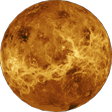
- It is the hottest in each eight planets of our solar system even hotter than Mercury.
- This major planet is the nighest to earth and 2nd closest to the sun aft Mercury. The median distance of Venus from the sun is 0.722 AU.
- The surface temperature of Venus ranges from '-220 °C to 465 °C'.
- Venus has some nicknames like "evening star", "morn star", "veiled planet", "earth's twin", and "earth's sister".
- It is the 2nd fastest planet that has an orbital speed of 35.05 km/unsweet and IT completes one orbit around the sun in 225 earth days.
- Planet Venus has high-topped squeeze on its surface. It is 92 times higher than the atmospherical pressure on earth.
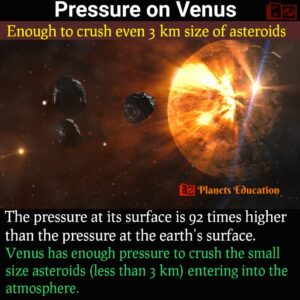
Read in detail:- Completely selective information of major planet Venus
3. Solid ground Facts 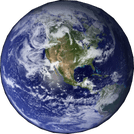
- Terra firma is the largest terrestrial planet and the only known planet that has life on it.
- Information technology is the 3rd satellite from the sun with a mean outdistance of or so 1 AU.
- It travels around the sun with a speed of 29.78 kilometre/sec and completes extraordinary orbit in 365.24 earth days.
-
The magnetosphere of the Earth protects U.S.A from harmful solar and big winds.
-
It is known as a 'blue planet' and 'reeking satellite' because of the large amount of water present thereon.
- 71% surface of the earth is covered with urine.
- The atmosphere of the earth has a supportive living environment. Earth's atmosphere has divided into different types of layers for different purposes.
- Earth has an ozone layer in its atmosphere that protects us from the harmful ultraviolet radiation of the sun.
Read almost:- Facts most Our Earth
4. Mars Facts 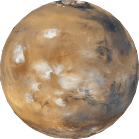
- The cavity speed of the raft is 24.07 km/sec and it completes one electron orbit around the solarize in 687 earth days. The mean orbital itinerary of Mars is just about 1.52 Atomic number 79 from the sun.
- It is also a 'red planet' because of a large amount of iron oxide present on it, which gives it a reddish coming into court.
- Mars has deuce cancel satellites, Phobos and Deimos.
- The highest well-known dozens 'Olympus Mons veneris' is connected the mars. It is approximately 22 kilometre high.
- Mars will besides take a phone around IT in the future. Information technology is estimated that its moon Phobos will tear apart after 30 1000000 long time that would create a ring around information technology.
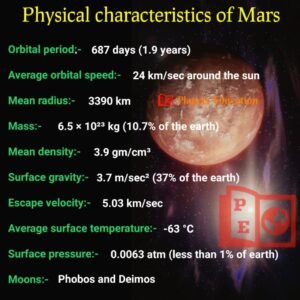
Must Say:- Facts of major planet Mars
Whale planets (outer planets)
There are also four giant planets; Jupiter, Saturn, Uranus, and Neptune. Jupiter and Saturn are named 'petrol giant planets' whereas Ouranos and Neptune are called 'ice giant planets'. They are quite bigger in sized, that's wherefore they are known as "giant worlds".
The outer planets are mostly ready-made of gases like hydrogen, helium, methane, and ammonium hydroxid. These worlds are massive and they have rings round them. One of the interesting facts about the out planet is, you can not stand on its surface as these are made of gases.
5. Jupiter Facts 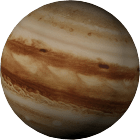
- Jupiter is the largest and most large of all 8 planets of our solar system with a aggregative of 1.9 × 1027 kg.
- The mass of Jupiter is to a higher degree 2.5 times greater than the mass of all other rolled into one planets. Its mickle is 318 times greater than the mass of earth.
- It has 79 known moons including four large Galilean Moons discovered by Galileo. Inhabitant Moons "lo, Europa, Ganymede, Callisto" are the largest four of Jupiter in which Ganymede is the largest in the solar arrangement and larger than the planet mercury.
(Read just about:- Jupiter Moons: Name calling, Numbers, and Tilt)
- Planet Jupiter is known as the 'winter planet' because of its low average temperature '-148 °C'.
- The cavum speed of Jove is 13.07 km/sec around the sun and it completes one orbit around the sun in 11.9 solid ground years. While its average distance from the sun is 5.20 AU.
- Jupiter has the shortest day compared to altogether planets that complete one reel round its axis in 9 hours and 55 minutes.
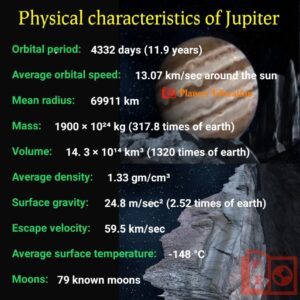
Read in detail: – Wholly about planet Jupiter
6. Saturn Facts 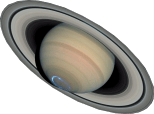
- This satellite is the 2nd largest in our solar system of rules with a mass of 5.7 × 1026 kilo.
- It is the sixth major planet from the sun with a entail distance of 9.58 AU.
- Saturn has heavy bright rings made of ice and dust particles that revolve about it.
- Our Saturn has the most number of moons in comparison to all otherwise solar system planets. It has 82 moons with their confirmed orbits. According to an estimation Saturn has millions of moonlets (moonlets are comparatively small natural moons that orbit a satellite). Moon 'Behemoth' is the largest of Saturn and 2nd largest in the star system. Check also:- Saturn Moons
- The cavum speed of Saturn is 9.70 km/sec and completes one revolution around the solarize in 29.5 land years.
Read in detail:- Facts about Saturn
7. Uranus Facts 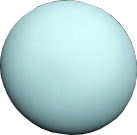
- It was the 1st major planet that was ascertained by victimization a scope in 1781 AD. Uranus is quite farther and the medium distance of this planet is approximate 19.20 AU.
- Ouranos is an ice giant planet and it is the coldest planet in our solar system with a recorded minimum temperature of '-224 °C'.
- The bodily cavity speed of the universe is 6.81 km/sec and information technology completes nonpareil rotation around the sun in 84 earth eld.
- IT has 27 known moons and the size of Uranus is about 4 times greater than the earth. (Show about- all the moons of Ouranos)
Read in detail: – Uranus Planet Facts
8. Neptune Facts 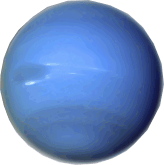
- Neptune is the 8th planet from the sun and the farthest one all told 8 planets of the solar system. The furthermost satellite has an average outdistance from the sun is 30.10 AU.
- Since IT is not visible to the naked eye indeed could not be disclosed aside ancient people.
- Information technology was 1st observed away John Couch Adams in 1846 AD.
- Neptune has the slowest orbital speed of 5.43 km/sec around the sun. It completes one reach around the sun in 165 earth years.
- Neptune has the lowest average planetary temperature in our star system.
- IT has 14 familiar moons in which 'Triton' is the largest.
Essential Tab:- Neptune Planet facts and information
Soh these were the 8 planets and their facts explained by Planets Education in the short terminal figure. They were described here ready of multiplicative distance from the sun.
I Hope you have liked reading and getting some interesting real facts approximately them. To read about them in detail, check the mentioned links for the kindred planets.
Frequently Asked Questions (FAQ)
What are the Planets ready from the Lord's Day?
The eight planets in order of growing aloofness from the sun are Mercury, Genus Venus, Solid ground, Mars, Jupiter, Saturn, Uranus, and Neptune . And these were the solar system planets in order from the sun. So, Mercury is the nearest and Neptune is the furthest one.
What are the Planets in order of size?
The higher up-enrolled planets are in order of distance from the Sun. And altogether the planets are different in size. You can match below the planets in order of size.
Must Check:- Size of it of Planets in Order
You own shown more or less real interest, so you power miss some unusual information about our solar organization. Equally we know our solar system likewise has some dwarf planets, comets, asteroids, and new star system bodies . Check here:-
- To read about the dwarf planets. And here make out more about some extraordinary overshadow planets like Pluto (largest), Ceres (nighest), Makemake (exist in the Kuiper belt region), Eris (farthest dwarf planet), and Haumea.
- Here read about the asteroid belt that contains millions of asteroids.
- You are non going to miss some interesting facts and info close to comets.
- Also, study about the Oort cloud that has billions of star system objects.
what is the 3rd planet in the solar system
Source: https://planetseducation.com/planets/
Posting Komentar untuk "what is the 3rd planet in the solar system"